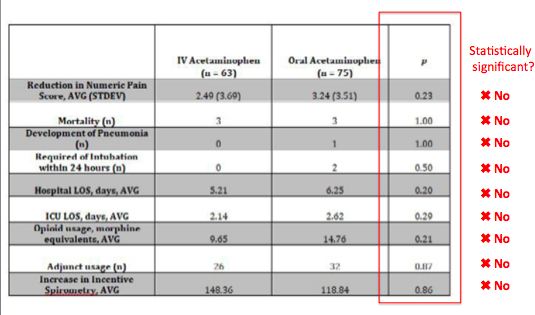The anti-opioid crusade remains alive and well (unlike the pain patients who are the victims of it). Call me crazy (1), but doesn't it seem that the "I can prescribe fewer painkillers than you" contest is still in full force?
An article on the Pain Network News site summarizes a meeting presentation of a small train wreck study entitled "Treatment With Oral Versus Intravenous Acetaminophen In Elderly Trauma Patients With Rib Fractures: A Randomized Controlled Trial" by Andrew Antill, MD and colleagues at the University of Tennessee Medical Center in Knoxville. In case you're in the mood to blow your head off with a bazooka become educated and wish to read the entire 292 page abstract of the entire meeting, here it is. If you're not so inclined, the study in question can be found on page 186.
What a mess.
The title suggests that in elderly patients with fractured ribs (a very painful injury):
- Oral and IV Tylenol work equally well in controlling pain.
- Therefore, Tylenol pills ($0.45 per dose) should be used in place of IV Tylenol ($180.00 per dose).
Not so fast. Aside from the cost, everything is wrong. Let's take a look.
SUMMARY OF THE STUDY
- The study was double-blinded and placebo-controlled.
- All patients (a total of 138) were 65 or older, had one or more broken ribs, and were admitted to a Level I trauma center.
- Patients were placed in either of two groups: 1) IV acetaminophen plus an oral placebo solution (63 patients) or IV placebo and oral solution acetaminophen (75 patients) (2).
- The primary outcome of the study was the mean reduction in pain score after 24 hours.
- There are more details, but I'm leaving them out. The study is so flawed that it doesn't matter.
PROBLEMS AND MORE PROBLEMS
Right away, two doozies jump off the page:
- The supposition that Tylenol in any form effectively treats pain. In fact, there is plenty of evidence that it does not (See: Tylenol Isn't So Safe, But At Least It Works, Right?).
- It's really cool right now for doctors to try to use IV Tylenol in place of opioids for post-operative pain. Minor issue: It doesn't work. (See IV Tylenol As Good As Moose Urine For Post-Op Pain Control.)
And we're just getting started.
You don't need to have ESP (or ESPN) to predict that when you give a drug that does little or nothing to relieve pain that both groups in the study are going to experience the same level of non-pain relief. The Antill study claims this but offers nothing but unsuitable evidence to back up the claim. Why? Lack of any statistical significance (emphasis mine):
Results: Among the 138 trauma patients included in the study ... there was no statistically significant difference between the two study groups in mean reduction in pain score at 24 hours after injury (p=.23). Mean reduction of pain scores on a 10 point scale were 3.24 in the PO acetaminophen group and 2.49 in the IV acetaminophen group.
The bolded text above only begins to tell us what a mess this thing is. First, the language is (at the very least) confusing and (at worst) intentionally misleading. Most people will read that sentence and conclude that IV and oral Tylenol work equally well in this group of patients. But this is not correct. What it really means: because the data don't even come close to attaining statistical significance this study provides no information whatsoever about whether IV Tylenol is better, worse, or the same as the pills or that either has any effect at all. Confusing? You bet. More on this below.

Original photo: Wikimedia
I haven't mentioned the study's secondary endpoints because if the data of the primary endpoint is bad, these are far worse.
For those of you who may not be familiar with the utility of p values, the following may help. P- values are a mathematical measure of the chance that the difference between two groups, sets of results, etc. are due to chance. The lower the number the more reliable the data (at least in theory). An article by the Institute for Work & Health gives a nice simple explanation:
Mathematical probabilities like p-values range from 0 (no chance) to 1 (absolute certainty)[that the data are a result of random numbers, not a real effect]. So 0.5 means a 50 percent chance and 0.05 means a 5 percent chance.
In most sciences, results yielding a p-value of .05 are considered on the borderline of statistical significance. If the p-value is under .01, results are considered statistically significant and if it's below .005 they are considered highly statistically significant.
Applying these criteria to the study results, the measurement of pain reduction (first column) has a p-value of 0.23, meaning that there is almost a one in four chance that the difference in the two groups is due to mathematical chance instead of real. In other words, it's useless data. But not as useless as the rest of it. I believe we are breaking new ground in the world of uselessness. Check out these numbers...

A data table without a single statistically significant value. Zero for nine! I don't think I've ever seen this before. Except for...

Tylenol also fails to alleviate the pain of watching the Yankees. Original photo: ESPN
So, by all means, let's give useless Tylenol to old folks with cracked ribs. A splendid idea, indeed. But, nothing out of the ordinary in these days of anti-opioid madness.
NOTES
(1) Get in line.
(2) Patients received opioids before the Tylenol was given, which may or may not have any bearing on the non-results of the study.




